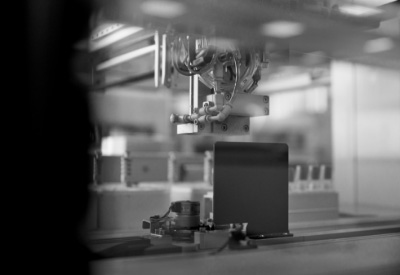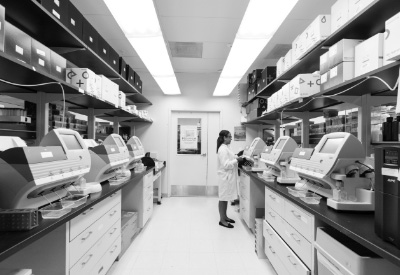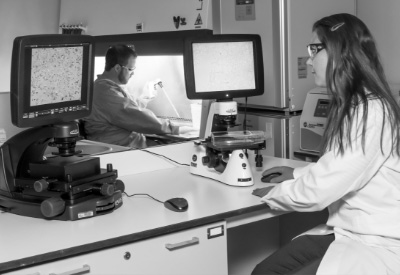January 2024 | Tips & Information
An Overview of Military Semiconductor Applications
Semiconductors play a crucial role in military technology, enabling the development of advanced communication systems, radar technology, and secure data encryption. This article highlights the significance of semiconductors in military operations and showcases how City Labs incorporates semiconductor technology in our NanoTritium™ batteries, which stand ready to revolutionize national defense efforts.
What Are Semiconductors?
Semiconductors are special materials with properties between those of conductors and insulators. These materials serve as the cornerstone of integrated circuits (ICs)—commonly known as semiconductor chips—which are the fundamental building blocks of almost all modern electronic devices. Due to its abundant properties and capabilities, silicon is the most widely used material in semiconductor manufacturing, contributing significantly to the semiconductor industry’s relevance, growth, and innovation.
The Science Behind Semiconductors
Central to semiconductor technology is the manipulation of the electrical properties inherent in materials. Doping, a process involving the introduction of specific impurities into the semiconductor material, creates an excess or deficiency of electrons, generating two types of semiconductors: N-type (excess electrons) and P-type (deficient electrons). The interaction between these types forms the basis of various electronic components like diodes, transistors, and integrated circuits.
Semiconductors play a crucial role in many modern electronic devices by allowing the controlled flow of electrical current. The basic science behind semiconductors lies in their atomic structure: Semiconductor materials possess a band gap—the difference in energy between the valence band (where electrons are tightly bound) and the conduction band (where electrons are free to move). This unique property allows semiconductors to behave as both conductors and insulators, depending on external factors, such as temperature or applied voltage.
Wide Bandgap Semiconductors Explained
Wide bandgap semiconductors possess unique properties, allowing them to operate at higher temperatures, frequencies, and voltages compared to traditional semiconductors like silicon. These materials, including silicon carbide (SiC) and gallium nitride (GaN), have wider energy band gaps, enabling them to handle higher power levels while maintaining efficiency.
These traits make them naturally desirable for military applications that may call for more energy-demanding use cases. Wide bandgap semiconductors also find applications in other industries—including power electronics, automotive systems, renewable energy, and telecommunications—due to their ability to improve energy efficiency and performance in high-power and high-frequency applications.
The Importance of Semiconductors in Microelectronics
Microelectronics play a crucial role in modern military technology. As a vital component of microelectronic devices, semiconductors are instrumental in enhancing performance and functionality.
In military applications, semiconductors are of utmost importance due to their ability to process and transmit vast amounts of data quickly and efficiently. They enable the development of advanced radar systems, communication devices, navigation systems, and weaponry. Semiconductors also enable miniaturization, making it possible to create smaller, lightweight military equipment without compromising functionality. Overall, semiconductors are indispensable in modern military technology, providing the foundation for advanced and efficient systems that are essential for defense and national security.
Semiconductors in Military Applications
Semiconductors play a crucial role in various military applications, contributing to communication systems, encryption technologies, radar systems, missile guidance, and electronic warfare. Their small size, low power consumption, and high reliability make them ideal for military technologies that require compactness, efficiency, and durability.
In communication systems, semiconductors are used in the development of advanced radios, satellite communications, and network infrastructure. They enable faster data transmission, improved signal quality, and enhanced connectivity.
Semiconductors also play a vital role in encryption technologies, ensuring secure communication and protecting sensitive military information from unauthorized access.
In radar systems, semiconductors are utilized in the creation of high-frequency amplifiers and signal-processing components. These components enable accurate detection and tracking of targets, enhancing situational awareness and aiding in threat identification.
Semiconductors are also utilized in electronic warfare, where they enable the creation of electronic countermeasures to disrupt enemy communications and radar systems. Semiconductor-based missile guidance systems utilize sensors and processors to calculate target trajectories and guide missiles toward their intended targets with precision and accuracy.
Military and Defense Applications for NanoTritium™ Batteries
City Labs’ NanoTritium™ batteries, a type of nuclear battery powered by tritium, offer a compelling solution for powering microelectronic devices for military and defense efforts. These batteries, renowned for their long lifespan and reliability, perfectly complement the demands of defense microelectronics, providing a stable power source for crucial systems where reliability is paramount.
Semiconductors are integral to the function of NanoTritium ™ batteries. Our nuclear battery technology leverages the characteristics of photovoltaic semiconductors and repurposes them for use in a betavoltaic system. Specifically, our tritium betavoltaic batteries employ semiconductor junctions to convert the kinetic energy of beta particles, which are generated through the decay of tritium, into electrical power—a process similar to how solar cells convert light into electricity.
The incorporation of semiconductors as a fundamental component of our batteries ultimately contributes to the long lifespan and resilience that make NanoTritium™ batteries stand out from the crowd. The U.S. military has already noticed the potential applications of City Labs’ batteries, having partnered with City Labs on several defense-related projects.
These projects include:
- The development of a tritium-based AA battery to enable 20+ year COMSEC crypto key security for the U.S. Air Force
- A self-powered wireless autonomous imaging sensor for the U.S. Space Force
- Another contract from the U.S. Air Force to adapt COMSEC systems to operate at the nanowatt power level
Semiconductor Shortage and the CHIPS Act
The global semiconductor shortage, exacerbated by the COVID-19 pandemic, has highlighted the vulnerability of relying solely on semiconductors manufactured at overseas foundries. This significantly impacted various industries, including defense and aerospace, emphasizing the need for robust domestic semiconductor manufacturing capabilities and a resilient supply chain ecosystem.
In response to this sudden deficit in the semiconductor market, the United States government passed the Creating Helpful Incentives to Produce Semiconductors (CHIPS) Act, a $280 billion package for research and development in the field of science—$52 billion of which is designated to enhance domestic semiconductor production and chip manufacturing.
The CHIPS Act aims to allocate funding for semiconductor manufacturing incentives, research and development, and the creation of a more robust semiconductor ecosystem within the United States. Such initiatives are critical to ensuring the nation’s self-sufficiency in semiconductor production for military applications, reducing dependency on external suppliers like TSMC (Taiwan Semiconductor Manufacturing Company).
The Future of Semiconductor Technology in Defense
The trajectory of semiconductor technology in military applications is poised for significant strides through ongoing research and development. Emerging trends, such as nanoscale semiconductors, flexible electronics, and quantum computing, hold immense potential to revolutionize defense capabilities.
These advancements promise enhanced performance, reduced size and weight, and heightened operational efficiency in military applications. From advanced sensors to high-speed communication systems, semiconductor innovation is poised to redefine the landscape of defense technology.
Upholding Security Through Semiconductor Advancements
Semiconductors undeniably serve as the cornerstone of modern military applications, underscoring their unmatched significance. As City Labs continues to advance NanoTritium™ batteries, semiconductors’ critical role becomes increasingly evident.
An in-depth understanding and adept utilization of cutting-edge semiconductor technology are pivotal to enhancing military capabilities and fortifying national security. City Labs remains steadfast in our commitment to harnessing state-of-the-art semiconductor technology to develop products that empower and safeguard our defense forces, contributing to a safer and more secure world.
We welcome you to join us in revolutionizing semiconductor technology for military applications. Contact us to explore collaboration opportunities and contribute to shaping a safer future for all.










